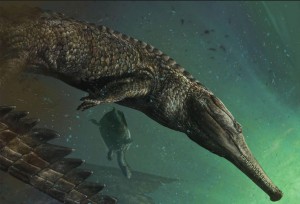Stand in Awe of This 30-Foot-Long Prehistoric Crocodile!
 Illustration by Davide Bonadonna
Illustration by Davide Bonadonna Many humanists dedicate tireless energy and time to advancing quality science education in our public schools. With the religious right attempting to remove the teaching of evolution from textbooks while also promoting charter schools as a surreptitious way to sneak religion into the classroom, humanist activists must be vigilant on many fronts. Toward this end, the American Humanist Association is supporting the Darwin Day Resolution in Congress, which would, if passed, affirm the importance of the teaching of evolution in public schools. But even as we work to defend sound education practices and the separation of church and state, we should also remember that evolution is really, really cool!
This week, I was struck by a reminder of how truly fascinating evolution is when I read about the new discovery of a prehistoric species similar to modern-day crocodiles. This reptile was over thirty feet in length, about the size of a large bus, and its head alone would have been over five feet long. Given the name Machimosaurus rex (M. rex), which means “fighting lizard king,” the animal had enormous, powerful jaws that would have made it one of the apex predators in its saltwater habitat. Scientists say that it would have been able to crush bone with its teeth (shaped like “armor-piercing bullets”) and that it likely ate turtles, as well as anything else that was unfortunate enough to pass near its huge maw.
M. rex is not only significant because it’s a previously unknown species. It also gives paleontologists clues about a global mass extinction that took place between the Jurassic and Cretaceous periods, about 150 million years ago. Scientists assumed that this mass extinction wiped out most marine reptiles, but M. rex appears to have been going strong until 130 million years ago, after this extinction was thought to have taken place. Based on this new evidence, scientists are revisiting their mass extinction hypothesis and will continue studying M. rex to better understand what was taking place on our planet during the transition from the Jurassic to the Cretaceous period.
Unfortunately, there’s only so much that paleontologists can glean from just the fossils they’ve managed to recover. M. rex was discovered in Tunisia, and security in the region is uncertain because of dangers posed by ISIS. Scientists aren’t sure when they’ll be able to return, and they fear that sandstorms in the region will bury or destroy the remaining M. rex skeletons. Among the many reasons for humanists to be disturbed by ISIS and the atrocities committed against human rights taking place in the Middle East, which are of paramount concern, these hindrances to scientific inquiry and the destruction of cultural heritage sites are often left out of the conversation.
Still, the discovery of M. rex itself is incredibly valuable in the information it provides about our planet’s past. Worth noting is the fact that M. rex is millions of years older than the six thousand years that creationists claim our planet has existed. This ancient reptile and the clues it holds to the transition from the Jurassic to Cretaceous years demonstrate the importance of understanding the age of our earth. The more we know about our planet’s past, the better we can predict its future, but the anti-science teachings of creationists and so-called intelligent design proponents prevent us from properly educating the next generation of scientists.
Creationists sometimes claim that the theory of evolution removes the mystery and beauty from the world around us. I would argue that anyone who makes this claim has never seen a child in a natural science museum. When confronted with prehistoric fossils of dinosaurs, fish, amphibians, and reptiles, many children’s eyes open wide in wonder as they gasp in awe at the diversity of lifeforms that have existed on Earth. I’ve seen children shriek in delight upon discovering that the fearsome-looking stegosaurus was actually an herbivore, and I’ve also heard children growl and roar in imitation of the imposing Tyrannosaurus rex. Someday, I hope that fossils of M. rex will also be included in museum exhibits for children and adults alike to study in wonder and awe.
As Darwin Day approaches (February 12), humanists must continue to be vigilant against attacks on our education system, but we must also remember the ways in which the theory of evolution beautifully describes our natural world. In our appreciation of science, humanists know that our planet is an astounding place, and we don’t need belief in gods or the supernatural to appreciate its beauty.
